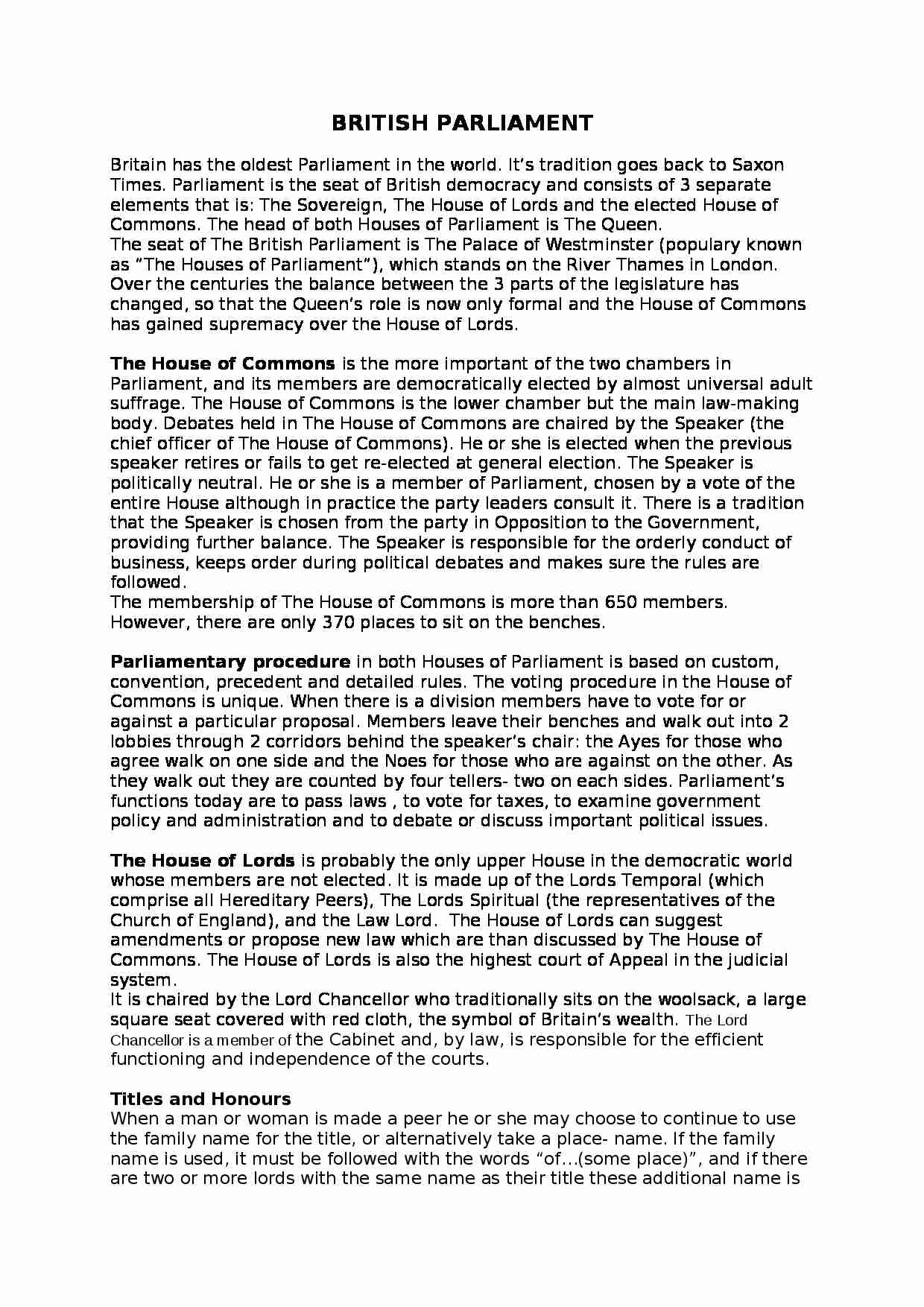To tylko jedna z 2 stron tej notatki. Zaloguj się aby zobaczyć ten dokument.
Zobacz
całą notatkę


BRITISH PARLIAMENT
Britain has the oldest Parliament in the world. It's tradition goes back to Saxon Times. Parliament is the seat of British democracy and consists of 3 separate elements that is: The Sovereign, The House of Lords and the elected House of Commons. The head of both Houses of Parliament is The Queen. The seat of The British Parliament is The Palace of Westminster (populary known as “The Houses of Parliament”), which stands on the River Thames in London. Over the centuries the balance between the 3 parts of the legislature has changed, so that the Queen's role is now only formal and the House of Commons has gained supremacy over the House of Lords.
The House of Commons is the more important of the two chambers in Parliament, and its members are democratically elected by almost universal adult suffrage. The House of Commons is the lower chamber but the main law-making body. Debates held in The House of Commons are chaired by the Speaker (the chief officer of The House of Commons). He or she is elected when the previous speaker retires or fails to get re-elected at general election. The Speaker is politically neutral. He or she is a member of Parliament, chosen by a vote of the entire House although in practice the party leaders consult it. There is a tradition that the Speaker is chosen from the party in Opposition to the Government, providing further balance. The Speaker is responsible for the orderly conduct of business, keeps order during political debates and makes sure the rules are followed.
The membership of The House of Commons is more than 650 members. However, there are only 370 places to sit on the benches.
Parliamentary procedure in both Houses of Parliament is based on custom, convention, precedent and detailed rules. The voting procedure in the House of Commons is unique. When there is a division members have to vote for or against a particular proposal. Members leave their benches and walk out into 2 lobbies through 2 corridors behind the speaker's chair: the Ayes for those who agree walk on one side and the Noes for those who are against on the other. As they walk out they are counted by four tellers- two on each sides. Parliament's functions today are to pass laws , to vote for taxes, to examine government policy and administration and to debate or discuss important political issues. The House of Lords is probably the only upper House in the democratic world whose members are not elected. It is made up of the Lords Temporal (which comprise all Hereditary Peers), The Lords Spiritual (the representatives of the Church of England), and the Law Lord. The House of Lords can suggest amendments or propose new law which are than discussed by The House of Commons. The House of Lords is also the highest court of Appeal in the judicial system. It is chaired by the Lord Chancellor who traditionally sits on the woolsack, a large square seat covered with red cloth, the symbol of Britain's wealth.
(…)
… chaired by the Lord Chancellor who traditionally sits on the woolsack, a large square seat covered with red cloth, the symbol of Britain's wealth. The Lord Chancellor is a member of the Cabinet and, by law, is responsible for the efficient functioning and independence of the courts. Titles and Honours
When a man or woman is made a peer he or she may choose to continue to use the family name for the title…
... zobacz całą notatkę




Komentarze użytkowników (0)